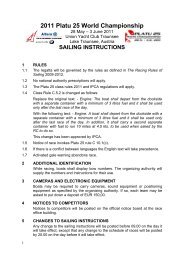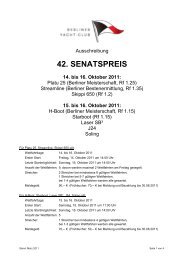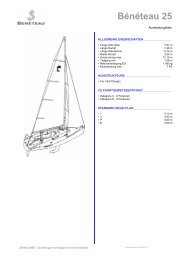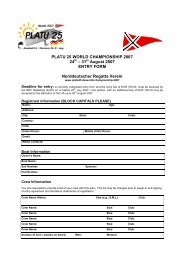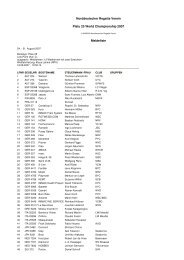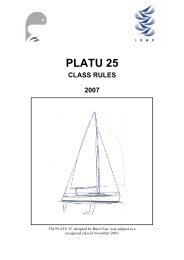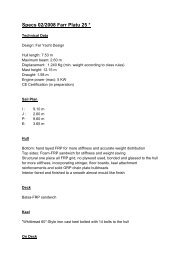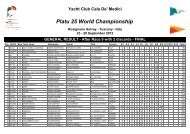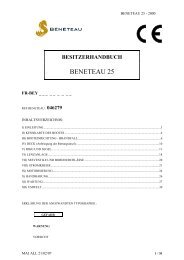NORTH SAILS ITALIA Bénéteau 25 O.D. Tuning Guide ... - Platu 25
NORTH SAILS ITALIA Bénéteau 25 O.D. Tuning Guide ... - Platu 25
NORTH SAILS ITALIA Bénéteau 25 O.D. Tuning Guide ... - Platu 25
Create successful ePaper yourself
Turn your PDF publications into a flip-book with our unique Google optimized e-Paper software.
<strong>NORTH</strong> <strong>SAILS</strong> <strong>ITALIA</strong><br />
have then to be fixed one to the other either using a short line which goes inside the turnbuckles bodies or,<br />
even better, a short batten. The above table is a simple tool we use to make tuning the rig on the water easy.<br />
Use a Loos Tension Model PT-2 tension gauge for all tuning. Once you have established the base setting on<br />
16/14, you can use this chart to count half turns up or down for the wind speed you are going to be racing in.<br />
You should ”set up for the lulls.” That is, tune your rig for the lightest wind speed you anticipate seeing in<br />
the course of the race. It is much easier to de-power the boat in a puff than power up an over tight rig in<br />
a lull.<br />
Remember to fix properly your turnbuckles once you have finished your tuning.<br />
3. Sail Trim<br />
Proper sail trim is a vital component of good boat speed in the Bénéteau <strong>25</strong> class As the boats are being<br />
sailed more and more like dinghies; aggressive and consistent sail trim is vital in order to keep the boat at<br />
maximum speed during constantly changing wind velocity. The following outline of sail trim will get you<br />
started towards having good consistent boat speed. Practice is the best way to get better at trimming your<br />
sails. Either by racing more or setting up two or three boat tuning sessions you’ll find that practice makes<br />
perfect. Ideally you will develop a true feeling for the correct trim, it is a good idea both to mark your sheets<br />
for reference and to trim sails following the feelings of the helmsman.<br />
Our goal when trimming the sails upwind is to keep the boat as flat and as easy to steer as possible.<br />
Ideally you want to steer the boat using sail trim and weight placement as much as possible. Use the helm as<br />
little as possible, thus reducing drag.<br />
For example, if we are fighting a lot of weather helm and are sure we have the rig tuned right and the correct<br />
amount of power in the sails, we will want to experiment with trimming the headsail slightly (to pull the bow<br />
down) and maybe easing the mainsheet or traveller which will also help to lighten the helm and bring the<br />
bow down.<br />
Conversely, if the helm is light and the boat always heels too much in the puffs we will want to look at<br />
easing the headsail and trimming the mainsheet. This will bring the bow up a couple of degrees, thus<br />
smoothing your steering, which keeps the boat tracking upwind.<br />
Downwind we are looking to also keep the helm neutral. Just like upwind we need to work the sails and crew<br />
weight in order to keep steering to a minimum. Watch some of the top boats downwind and you will find that<br />
their crews are constantly in motion to keep the boat flat so the skipper does not have to use the tiller.<br />
Mainsail<br />
The mainsail sheet purchase has to be as powerful as possible (6:1). In order to make the shortest possible<br />
the sheet, fix a 40 cm Spectra “core” line 10 mm diameter to the boom and the upper purchase block. Put a<br />
ratchet on the lower block, if there is not.<br />
Trim the mainsheet in order to make the boom nearly on the centreline, 5-10 cm down in light-medium<br />
wind. If the mainsheet is too tight (evidenced by the top batten hooking to weather and too round) you will<br />
slow down. In light air and choppy water, the top batten should be parallel or twisted off slightly. Always<br />
check the top telltale on the leech of the main. It should be flying 50/60% of the time within 10 knots of<br />
wind; above you will use more backstay and the upper part of the sail will get flatter, the top telltale has to be<br />
flying 100% of the time.<br />
9




